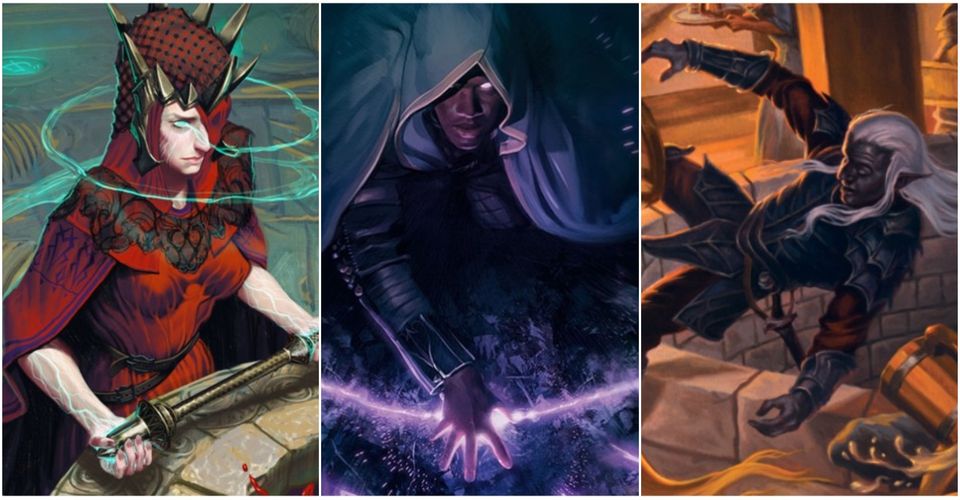15 Craziest Classes In Dungeons & Dragons (That Are Actually Extremely Powerful)

Dungeons & Dragons helped to codify the structure of a basic adventuring party, which has since gone on to be used in numerous other tabletop RPGs and video games.
The ideal party should have four members, with the lead character being the melee fighter who can rush into combat and take plenty of hits. One character should possess skills that help the party to survive in harsh and unknown environments, while also dealing pinpoint strikes in combat.
There should also be two spellcasters– one with the power to heal and buff the party, while the other deals damage and weakens the enemy with status effects.
There are lots of deviations on this format, but lacking any of those essential elements will make it harder for the group in the long run.
Not all character classes are so easy to quantify, though, as there are some that will attempt to break the mold and do something a little different. A lot of players will scoff at these archetypes, kits, and prestige classes for attempting to be a jack of all trades, yet there is a lot of hidden potential to be found in a character class that tries to be unique.
We are here today to look at the most unusual characters classes that have appeared in the various editions of Dungeons & Dragons. These classes might look weird, but they secretly possess a lot of power.
Here are the 15 Craziest Classes In Dungeons & Dragons (That Are Actually Extremely Powerful)!
15 Thrall Of Juiblex

Juiblex is one of the demon lords of the Abyss. It is considered to be a deity by the numerous evil slime and ooze monsters that roam the dark corners of the world.
Juiblex was notorious in the third edition of Dungeons & Dragons for being one of the easiest high-level creatures to defeat, especially when you consider the fact that is meant to be a demon lord and ruler of one of the layers of the Abyss.
Only the craziest of humanoids would consider worshiping a creature like Juiblex, as it’s a slime monster that wants to destroy everything around it. Juiblex doesn’t grant spells to its followers, but there is a great power to be had by emulating the evil lord of slime.
There was a prestige class in the Book of Vile Darkness called the Thrall of Juiblex. This was a relatively easy prestige class to take on and it offered some amazing abilities.
The Thrall of Juiblex can summon powerful slime monsters for free (though only one can be summoned at a time), they obtain a range of built-in attacks (such as being able to spew acid and their touch being corrosive) and they eventually develop the ability to cast polymorph self at will.
A 10th level Thrall of Juiblex becomes an amorphous creature, which means that they become immune to critical hits, sneak attacks, poison, paralysis, and stunning.
14 Breachgnome

Gnomes might be the least popular race in Dungeons & Dragons in terms of how often they are selected by players. This is partly due to a lack of representation in other forms of media, as franchises like The Lord of the Rings are filled with humans, elves, halflings, and dwarves, yet gnomes seem to be unique to Dungeons & Dragons.
Gnomes are less hardy than their dwarven cousins, which is why they rarely take on martial classes. Gnomes are skilled with magic and music, which means that they are often better suited to be arcane spellcasters and bards than as warriors.
There is one gnome prestige class that gives the forgotten folk an amazing boost in combat. The Breachgnome class is a prestige class for gnomes who specialize in fighting in tight spaces. They possess abilities that kick in when they are fighting in corridors or other cramped environments.
Dungeons & Dragons players have long known about the benefits of creating a bottleneck in their environment, in order to prevent being swarmed by superior numbers.
Breachgnomes thrive in this environment, as they gain a boost to their armor class while fighting in corridors. They also gain a huge boost to their attacks of opportunity and any attempt to use the Tumble skill to get past them has the skill check increased by ten.
Breachgnomes also quickly gain access to Uncanny Dodge, which makes it almost impossible for enemies to gain an advantage through surrounding the gnome.
13 Bard Of The College Of Satire

The current edition of the Player’s Handbook offers two archetypes for bards in the form of colleges.
When a bard reaches third level, they can choose between following the College of Lore (which grants access to more magical spells and abilities) or the College of Valor (which gives them more combat abilities and improves their Bardic Inspiration ability.)
One of the alternate archetypes for bards is the College of Satire. These are the similar to jesters, as they specialize in using their abilities for entertainment purposes, while also making their enemy look the fool by turning them into the butt of the joke.
Bards who follow the College of Satire gain access to some of the best rogue abilities, which includes proficiency with thieves tools and the Sleight of Hand skill.
They also have the Tumbling Fool ability, which works like Cunning Action (possibly the best rogue ability in the game) except that they also gain the ability to climb at their regular movement speed and take half damage from falls, though they cannot attempt to use the Hide skill as a bonus action.
As a bard who follows the College of Satire levels up, they gain the ability to cast detect thoughts several times a day and can use their Bardic Inspiration ability on themselves when they fail a check, though they will have to take a penalty on a later check in order to use that ability again.
12 Streetfighter

The vast majority of Dungeons & Dragons adventures take place in exotic locations, such as a floating castle or an abandoned city in the middle of a jungle. You don’t see many Dungeons & Dragons adventures that take place in cities, as most settlements are only used as a place for the players to sell their loot and buy new items.
There are a few character classes that are intended for games that take place in cities, which means that they are rarely used.
One of the prestige classes that appeared in the Complete Adventurer might seem like a city-based class on the surface, but it actually has some awesome abilities. This is the streetfighter class, which has no relation to the video game of the same name.
The streetfighter is someone who honed their skills in fight clubs and tough man contests, which has made them skilled in boxing and brawling. One of the advantages of becoming a streetfighter is a bonus to initiative, making them one of the few classes to receive this benefit, as well as receiving Sneak Attack and Uncanny Dodge.
The real benefit of taking levels in streetfighter is due to their Stand Tough ability, which allows them to make a Fortitude saving throw when being hit.
If they pass the saving throw, then they only take nonlethal damage from the blow and the damage is reduced by half.
11 Windrider

Advanced Dungeons & Dragons introduced the concept of kits, which were similar to the archetypes of later editions, except that you received the benefits from level one and most of them weren’t a huge difference in terms of their abilities.
There were a few exceptions to this, such as the amazing archer and bladesinger kits, but these were the exception.
One of the most unusual kits in Advanced Dungeons & Dragons appeared in The Complete Book of Elves. This was the windrider kit that was exclusive to elven characters.
Windrider is the title given to the elven cavalry who are mounted on flying creatures. A windrider doesn’t gain any benefits until they reach level four, five or six, which is the point when they are given a flying mount.
The windrider can choose between a griffon, a hippogriff, or a pegasus. They gain numerous benefits when fighting on this mount, which makes them incredibly effective when fighting in an open space.
The special hindrance of the windrider is that they receive a penalty on reaction rolls, due to other people being so jealous of their flying mounts.
This is one of the few instances where a character receives a penalty for being too awesome.
10 Geomancer

The Geomancer is an unusual prestige class in that it gains some amazing benefits, but they will totally change the physical appearance of your character. By the time you reach the tenth level in Geomancer, you will resemble a mixture of many different animals that have had their defining features jumbled together.
Geomancers are those individuals who wish to blend arcane and druidic magic together. One of the benefits of this is their Spell Versatility ability, which allows them to mix and match certain attributes from both of their spellcasting abilities.
A Geomancer can cast arcane spells in light and medium by making them closer to druidic spells, as well as swapping the stat that gives bonuses to each spell.
The real reason people pick the Geomancer class is due to their Drift ability. Drifts are physical changes that permanently alter the appearance of your character.
The first stage of Drifts are fairly benign and have no influence on gameplay, such as giving your character zebra stripes or turning your hair into vines, but the advanced Drifts give you special powers.
The high-level Drifts include gaining a camel’s hump (which means you can survive without water for longer), an extended jaw that resembles a crocodile, a giant stinger like that of an ant, and a unicorn’s horn on your head.
9 Blood Magus

The blood magus has one of the most difficult requirements of any prestige class in all of Dungeons & Dragons, as you need to have perished and been brought back to life through the aid of magic in order to pursue the class.
Those who are revived will gain a new appreciation for their blood, as they know what it’s like to be without it. The blood magus gains several powerful abilities that are linked to the plasma that courses through their veins.
A blood magus can increase the caster level of their spells by shedding a drop of blood, which makes their spells harder to resist.
They can scribe spells into their skin, in the form of horrific scars. A blood magus can also store potions in their blood, which means that they will always have magic items in their possession.
The body of a blood magus also becomes more physically durable, as they are less likely to fail a concentration check when being attacked while casting a spell. A blood magus will always stabilize when they drop below zero hit points, which means that they cannot bleed out and perish on the battlefield.
The most powerful ability of a blood magus is their Bloodwalk ability, which allows them to teleport by stepping into the body of another person and exiting through someone else.
The range of this ability is incredible, as you can use it to appear anywhere on the same plane of existence. You can also exit an enemy’s body a little early, dealing them 10d6 damage as you erupt from their blood.
8 Void Disciple

The four classic elements tend to appear in most Dungeons & Dragons games. This is due to the fact that the prime material plane (the setting for most games) is surrounded by four elemental planes that are made up of air, earth, fire, and water.
There are some Dungeons & Dragons games that include a fifth element, which is the void.
There are a few individuals who wish to study the power of void and its relation to all things. These people become void disciples, who are essentially scholars who use their knowledge of nothingness to wield some of the best abilities in the game.
A void disciple can use the Sense Void ability to separate their mind from their body. This is one of the best scrying abilities in the game, as you can see anything within the radius of your powers, which only gets bigger as you level up.
The ultimate power of the void disciple is their Moment of Clarity ability. This allows them to touch an ally and give them access to any skill or feat in the game, except for ancestor feats. This effect lasts for one round per void disciple level.
The ramifications of this ability are staggering, as you can give another character access to the best feats in the game with only a touch.
You can make your warrior friends fight with two-weapons without any penalties or allow the spellcasters to use two wands at once.
7 Master Thrower

Dungeons & Dragons is a game where most of the martial characters rely on melee weapons, such as swords and axes, or ranged weapons, such as longbows and crossbows.
You don’t see much representation for thrown weapons outside of handaxes, which has more to do with their versatility than their effectiveness in combat.
There is one prestige class in The Complete Warrior that will turn you into a darts player of destruction, as the master thrower is surprisingly broken for a class that is based on tossing random items and improvised weapons at the enemy.
The reason the master thrower class is so powerful is due to their Thrown Weapon Trick ability, which allows them to perform some amazing feats when using a thrown weapon.
The various tricks allow you to throw two weapons in a single action, as well as increasing the number of times you multiply the damage of a critical hit.
A high-level master thrower can also turn their attack into a ranged touch attack, which deprives the enemy of their armor class bonus, though you lose any bonus damage that you would receive from a high Strength score.
This can be combined with the Sneaky Shot trick, which allows you to try to fool your enemy. If they fail a Sleight of Hand check, then they also lose their Dexterity bonus to their armor class.
6 Earth Dreamer

The presence of magic in Dungeons & Dragons allows players to temporarily bend the rules of the game in their favor. This can be used with spells such as fly, which allows you to move through the air at will.
A high-level character can also use spells like wish and miracle to try and break reality itself, though this often ends poorly for the player.
The vast majority of Dungeons & Dragons games involve adventures that take place underground, hence the “Dungeons” party of the title. This means that any spell which can affect solid ground will be of use to the player.
There is a class in the Races of Stone book called the earth dreamer, which has some of the easiest requirements of any prestige class in the game. You have to sit through three levels of bad abilities before you hit paydirt, as the earth dreamer is about to make life hell for the dungeon master.
When an earth dreamer hits fourth level, they gain the ability to see through dirt as if they had x-ray vision, though it only extends thirty feet. When they hit fifth level, they gain the ability to move through the earth as if it weren’t there.
A high-level earth dreamer is going to make it a lot harder for the dungeon master to write adventures that are set underground, as the earth dreamer could just scout out the entire place by swimming through the ground and using their vision to see through all of the obstacles.
5 Drunken Master

In the third edition of Dungeons & Dragons, all monks had to be of a lawful alignment. This was meant to represent the dedication and hard work that goes into being a magical martial artist.
There are some monks who fall off the path of discipline and decide to become drunkards. These monks can still retain their skills by taking levels in the drunken master prestige class.
The drunken master gains benefits from fighting while inebriated. If a drunken master consumes a large tankard of ale or a bottle of wine, then they gain +2 to their Strength or Constitution, in exchange for a -2 penalty to both Intelligence and Wisdom.
The unpredictable mannerisms of a drunken master mean that they have the best charge attack in the game, as it doesn’t have to be in a straight line and a successful Tumble check means that it doesn’t provoke attacks of opportunity.
As the drunken master becomes stronger, they gain the ability to drink bottles of ale and give them the same effect as a potion of cure moderate wounds three times per day.
This culminates in the ability to turn the alcohol in their body into a breath weapon, which allows them to spit out a blast of fire.
4 Malconvoker

The summon monster spells are pretty useless when cast by a low-level mage, as the creature only hangs around for one round per character level. As your character gets stronger, they will gain the ability to summon a wide-range of creatures and they will stick around for a lot longer.
One of the risks of using the summon monster spell is that it gives you the chance to summon demons and devils, which may affect your alignment.
There is one prestige class that specializes in tricking evil monsters into serving them. The malconvoker possesses the ability to use a Bluff check in order to make their fiendish monsters stay for double the regular duration of the summon monster spell.
This will grant buffs to the demons and devils as the malconvoker becomes stronger.
The malconvoker possesses the ability to cheat the normal summoning rules when using magic to summon fiendish creatures into battle. A malconvoker can summon extra demons & devils when using the summon monster spell to bring forth several creatures at once.
As they level up, they will become experts at using the planar binding spells, to the point where the hit dice limit for the creatures that they can summon is raised.
3 Jester

The bard class has undergone many different shifts in their abilities and roles over the years. They started out as being one of the most powerful classes in the first edition of Dungeons & Dragons, before becoming the jack of all trades class that had lots of different skills.
The current version of the bard is one of the best healers and buffers in the game.
The version of the bard that appeared in the original version of the third edition of Dungeons & Dragons left something to be desired, which is why it was overhauled in the 3.5 update of the game.
The people at Dragon magazine decided to take matters into their own hands and they created their own alternative to the bard, which was called the jester. This class was so popular that it made its way into the Dragon Compendium.
The jester is like a more useful version of the original bard. They possess the Jester’s Audacity ability, which grants them an armor class bonus in combat.
Jester’s also possess the Jester’s Performance ability, which allows them to manipulate the enemy into attacking them, by using their comedic skills to infuriate the foe into losing their cool.
Jester’s are also masters of crowd control, as they possess the ability to fascinate or calm down crowds using their performances. Their powers even possess the ability to affect the intelligent undead, which means that even a vampire can fall prey to a terrible pun.
2 Chaotician

The fate of an entire Dungeons & Dragons world can rest on a single roll of a dice. The climactic battle against an evil wizard who is about to bring about the apocalypse can quickly end in tears if the heroes keep rolling ones and twos.
The random nature of the universe has not gone unnoticed by the denizens of the Dungeons & Dragons universe, which has led to some people wielding the power of chaos itself in order to tip the odds in their favor.
The chaotician is someone who has learned the truth of their reality and tries to live their life in as chaotic a manner as possible. This knowledge allows them to use abilities like Anarchic Grace, which is a stance that is so unpredictable that enemies will have a 50% chance of missing all of their attacks.
Chaotician’s possess the ability to turn all speech into gibberish, which prevents spellcasters within a ten-foot radius from casting spells.
When a chaotician has reached the limits of their knowledge, they will gain the ability to have a reality do-over. This means that the player can reroll one dice roll that they had made that day.
The study of chaos has given them the insight they need to avoid critical fumbles.
1 Divine Prankster

The major demihuman races all have their own patron gods who take care of them. The most unusual of these is Garl Glittergold, who acts as the diety of the gnome race.
Garl Glittergold is a prankster god, who loves jokes and tricks more than anything. Garl’s comedic nature is emulated by his followers, with his clergy engaging in immature pranks during their sermons.
The power of comedy should never be underestimated, as those gnome clerics who achieve a deeper understanding of Garl Glittergold’s wisdom can take levels in the divine prankster class.
A divine prankster will gain similar abilities to a bard, as they can inspire their comrades or manipulate their enemies using the power of their words.
They can also use their subterfuge skills to hide the somatic components of a spell, as well as using Bluff checks to avoid attacks of opportunity.
The ultimate power of the divine prankster class comes in the form of the Killing Joke ability. If the divine prankster is able to spend three rounds setting up their joke, then they can force the enemy to make a will save or immediately perish.
This means that there is a class in Dungeons & Dragons with the ability to tell the world’s funniest joke from Monty Python’s Flying Circus.
—
Can you think of any other crazy Dungeons & Dragons classes that are actually extremely powerful? Sound off in the comments!
About The Author


















